Touring the Wayne Wonderland – Before the Automobile
George C. Fraser’s adventures in the Capitol Reef Country
by Frederick H. Swanson
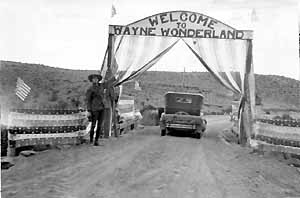
In July, 1925, residents of the Torrey-Teasdale area celebrated the scenic features of the Waterpocket Fold with a two-day festival. They hoped to attract more tourists and get a “Wayne Wonderland” state park established in the Fruita area. Their efforts led to the designation of Capitol Reef National Monument in 1937. Photo by Dave Rust; collection of Blanche Rust Rasmussen.
Twentieth-century tourism was slow to come to the Waterpocket Fold country, at least in comparison with some of the more famous geologic wonders of the Colorado Plateau province. By the 1920s, when a few Wayne County residents such as Joseph Hickman and Ephraim Pectol were beginning to publicize the scenic features of the “Wayne Wonderland,” places such as Zion, Bryce and Grand Canyon national parks were already accommodating visitors by the thousands. In 1929, to take one year, Bryce Canyon saw 22,000 tourists arrive, Zion saw 33,000, and the Grand Canyon hosted 184,000 travelers. These destinations, of course, were flagged on everyone’s road maps, while the designation of Capitol Reef National Monument was still eight years in the future. Just as important, tourists could enjoy traveling on decent roads to the flagship parks of the region. In contrast, any motorist who tried to get through the Waterpocket Fold in those days had to contend with potential flash floods in Capitol Gorge, where the roadway ran right down the wash bottom. Once past this barrier there was still the notorious Blue Dugway over toward Caineville, where rains could turn the dusty shale road into dangerously slick gumbo.
In the early days of the twentieth century it took a special kind of traveler to make the long journey to this region. Typically, he or she was well educated and had read about the geologic and scenic features to be found here. A good income was needed, too; the expense of rail travel, as well as the cost of hiring a local guide and pack string, was considerable. One gentleman who fit this description was George Corning Fraser (1872-1935), a resident of Morristown, New Jersey who was something of a nut about the Southwest. Although he practiced law as a partner in a Wall Street firm, his passion was geology, in which he had majored at Princeton. There he had read the wonderful geologic monographs and studies of the Powell Survey, including the classic works by Capt. Clarence E. Dutton — his Report on the Geology of the High Plateaus of Utah (1880) and the Tertiary History of the Grand Cañon District (1882).
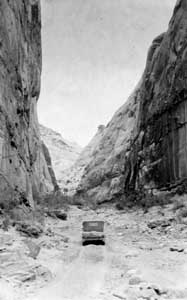
Early Wayne County settlers pioneered the “road” through Capitol Gorge in the Waterpocket Fold, but even by the 1920s the route was hardly any easier. Collection of Blanche Rust Rasmussen.
After Fraser became established in his law practice and could take some time off, he turned his attention to the great American Southwest. From 1914 to 1930 he made a series of long journeys to some of the most remote corners of this region, traveling by horse and wagon, and later by automobile. His first trip took him to Zion Canyon and the North Rim of the Grand Canyon in 1914, where he explored all along the Kaibab Plateau and made a difficult descent of the canyon via the Bass Trail. He engaged a local guide, Dave Rust of Kanab, to pilot him and his seventeen-year-old son through this region (see “Dave Rust, Pioneering Utah Outdoorsman and Guide,” by William W. Slaughter, on the Entrada Institute website).
Like many educated people of the time, George Fraser was a good writer and he kept a detailed journal of his travels. In it he recorded his impressions of the local geology, the interesting characters he met on the trail, and vignettes of life in the small towns and hamlets of the region. His journals make interesting and sometimes humorous reading – a sort of snapshot of a disappearing frontier.
Fraser and his son George Jr. continued to follow in Clarence Dutton’s footsteps in 1915, when they again joined Rust for a five-week, six-hundred mile-long horseback journey through the High Plateaus of Utah. Their route began at Salina, Utah, and headed up into the high country around Mt. Terrill. From there they traversed the Fishlake Plateau before dropping down into the lush Fremont River valley. Fraser’s ambition was to stand at the same lookoff points used by Dutton and other government geologists and surveyors, and try to understand the landscape with their eyes. By spending hours at such high vista points as Thousand Lake Mountain, Mt. Ellen, and the edge of the Aquarius Plateau, he was able to piece together the amazing geologic story of this folded and contorted landscape.
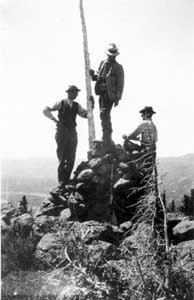 Fraser got down into the depths too, for a close acquaintance with the desert. After spending a chilly night on the top of Thousand Lake Mountain, Dave Rust led the Frasers down through Hartnet Draw into the remote and forbidding South Desert. There they paused on a rocky promontory to view the weird erosion-formed spires of what is now called Cathedral Valley. Back then this area had no special name, and was known only to a few cowboys who chanced to pass through. In fact, as a teenager in the 1880s, Dave Rust had herded his family’s sheep in Cathedral Valley. He knew how to find the few water sources and trails in this desolate area – something that impressed the city-dwelling Fraser.
Fraser got down into the depths too, for a close acquaintance with the desert. After spending a chilly night on the top of Thousand Lake Mountain, Dave Rust led the Frasers down through Hartnet Draw into the remote and forbidding South Desert. There they paused on a rocky promontory to view the weird erosion-formed spires of what is now called Cathedral Valley. Back then this area had no special name, and was known only to a few cowboys who chanced to pass through. In fact, as a teenager in the 1880s, Dave Rust had herded his family’s sheep in Cathedral Valley. He knew how to find the few water sources and trails in this desolate area – something that impressed the city-dwelling Fraser.
After a stop in Caineville, the party headed up into the Henry Mountains for more views. There they met several local sheepherders, including rancher George Coleman and a young man named Leland Busenbark. Both proved to be welcoming hosts, and some of Fraser’s most engaging descriptions are of these and other local residents. The Frasers and Rust waited out a nasty windstorm on the slopes of Mt. Ellen, taking refuge in Busenbark’s tent. “Busenbark has an attractive personality and a strong character,” Fraser wrote. “After dinner he produced a violin, with many apologies because it only had three strings. Nevertheless he played on it some familiar airs that did not sound cheering. I never realized how important a string could be.”
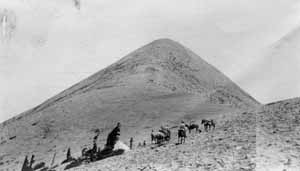 Following their stay on Mt. Ellen, the party rode down to spend a night at George Coleman’s ranch on Sandy Creek at the edge of the Waterpocket Fold. They continued their eastward journey up through the Fold and onto the Aquarius Plateau, where they were royally hosted by forest ranger Walter E. Hanks and his family. Such hospitality proved to be the rule throughout their journey, with men and women living in isolated sheep camps and ranger stations eager for news and company from the outside world. Fraser wrote in his journal that “the Hanks children brought us five trout, which they had got that morning, beside more milk and butter. On leaving Mrs. Hanks invited us to return with our entire family and to spend the best part of any summer. I think she meant it. She gave Rust a large pot of wild elderberry jam made by herself, which we hugely enjoyed.”
Following their stay on Mt. Ellen, the party rode down to spend a night at George Coleman’s ranch on Sandy Creek at the edge of the Waterpocket Fold. They continued their eastward journey up through the Fold and onto the Aquarius Plateau, where they were royally hosted by forest ranger Walter E. Hanks and his family. Such hospitality proved to be the rule throughout their journey, with men and women living in isolated sheep camps and ranger stations eager for news and company from the outside world. Fraser wrote in his journal that “the Hanks children brought us five trout, which they had got that morning, beside more milk and butter. On leaving Mrs. Hanks invited us to return with our entire family and to spend the best part of any summer. I think she meant it. She gave Rust a large pot of wild elderberry jam made by herself, which we hugely enjoyed.”
And this was only the midpoint of their journey. Further adventures awaited as the party visited the Table Cliff Plateau, Brian Head (still a wilderness summit then), the Kolob Plateau, and Pine Valley Mountain. Few outsiders and virtually no tourists had ever seen this country. George Fraser was hardly finished with his travels, however; he returned in 1916 to join Dave Rust for a long traverse of the northern Navajo Reservation, including a visit to Rainbow Bridge. He brought his wife and his daughter Ann out for another trip in 1921, visiting Bryce Canyon, among other features. He returned with his daughter Jane in 1922 for a pack trip to the Crossing of the Fathers. At the beginning of this trip he attended the Fourth of July celebration in Teasdale, watching a horse race and taking part in a town dance. Travel in those days often brought one into close contact with local people – so different from today’s tourist who encounters locals chiefly behind a convenience store counter.
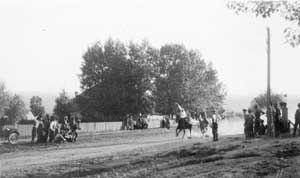 The historian Stephen C. Jett once wrote that Fraser “seems to have been fascinated by nearly everything.” His journals certainly give that sense, for he recorded not only the stunning landscapes he saw but such items as local agricultural production and the particulars of people’s lives. He was able to get complete strangers to open up to him, despite his upper-class bearing. Reading his journals, one gets the feeling that modern travel could be just as rewarding. True, the wild country Fraser saw has changed forever, and the world has discovered many of his hidden campsites. But an open and curious mind remains just as essential today when making a trip to the wonderland country of central Utah.
The historian Stephen C. Jett once wrote that Fraser “seems to have been fascinated by nearly everything.” His journals certainly give that sense, for he recorded not only the stunning landscapes he saw but such items as local agricultural production and the particulars of people’s lives. He was able to get complete strangers to open up to him, despite his upper-class bearing. Reading his journals, one gets the feeling that modern travel could be just as rewarding. True, the wild country Fraser saw has changed forever, and the world has discovered many of his hidden campsites. But an open and curious mind remains just as essential today when making a trip to the wonderland country of central Utah.
Join author Frederick H. Swanson on Saturday, May 28, 2005 at the Entrada Institute in Torrey, Utah, for a slide-illustrated program on George Fraser’s adventures in the Wayne Wonderland region. Mr. Swanson has edited Fraser’s journals and presented them in Journeys in the Canyon Lands of Utah and Arizona, 1914-1916 (University of Arizona Press, 2005). The program begins at 7:30 and is free to the public. Copies of his book will be available for purchase and signing. Read an Excerpt from the Book
